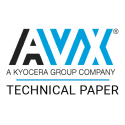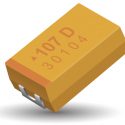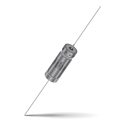Tantalum and Oxicap® Niobium Oxide Capacitors Deliver Enhanced Reliability, Wide Temperature Range & Low Leakage for Automotive Applications Written By: R. Faltus Abstract: In nowadays modern cars we can find many electronic systems controling engine, gear box, caring for passenger comfort, assuring safety and security, etc. Automotive applications are specific by their harsh electrical and environmental conditions together with requirements for high overall reliability and lifetime. Any electronic part used in such system play important role to assure reliability and functionality. Different capacitor technologies –tantalum, MLCC, NbO, aluminium are available but some of them meet the specific requirements better than others.
Technical Articles / Whitepapers
Tantalum and Niobium Technology Roadmap Written By: T. Zednicek | B. Vrana | W. A. Millman | J. Gill | Chris Reynolds Abstract: This paper presents an overview of the key features of emerging capacitor technologies – tantalum, niobium metal and niobium oxide in order to give designers a better understanding of the potential applications and to guide their choice of component solutions for their individual requirements. The second part of the paper is targeted to a new type of solid electrolyte capacitor that has been developed based on niobium oxide powder material. Capacitors made from niobium oxide powder offer the designer many interesting features such as significantly reduced ignition failure mode, better load resistance, reduced cost, etc. The paper
TA Capacitors With Conductive Polymer Robust to Lead Free Process Written By: Z. Sita | M. Biler Abstract: Tantalum capacitors with conductive polymer cathodes have found a place in the market as a low ESR component with reduced ignition. Conductive polymer cathodes however, suffer from instability during multiple high temperature thermal treatments such as lead free soldering due to its limited self healing ability and lower thermal and mechanical strength compared with manganese dioxide. This makes capacitors with conductive polymer cathode more sensitive to thermo-mechanical stresses, which appear during soldering and to negative influences of storage condition after removal from the protective packaging prior to soldering. This paper describes methods of improving the robustness of such capacitors with lead free
Storage Capacitor Properties and Their Effect on Energy Harvester Performance Written By: Radovan Faltus | Miroslav Jáně | Tomáš Zedníček Abstract: The development of energy harvesters has quickened up in the last few years mainly due to semiconductor improvements. But power sources for energy harvesters usually exhibit high internal impedance and can therefore only deliver low currents. The most important consideration for harvesting is that the power consumption of the controller circuitry must be less than the energy generated by the power source. Energy harvesters use a storage capacitor slowly charged from power source through the controller and the leakage current of this capacitor is wastes a certain percentage of the generated energy. This paper will evaluate this effects of
SMD Tantalum Capacitors Break Limit of 200degC for Continuous Operation Written By: R. Faltus | T. Zedníček Abstract: Capacitors are one of the key parts of any electronic device and system. The main functions of capacitors include power supply voltage smoothing, supporting energy sources when high current pulse is demanded, blocking a DC voltage in signal pathes, filtering, etc. To assure required functionality of a system we cannot omit capacitors and it is valid for high temperature applications as well. In oil and gas mining industry a high temperature capacitors are needed for DC/DC converter of drilling heads that are subjected to rising ambient temperature with depth. Thus the higher permitted operating temperature of used capacitor and other passive and
Smallest and Lowest Profile Tantalum Capacitors Written By: T. Zednicek | I. Paukert | I. Zednickova Abstract: Tantalum capacitor technology has been recognized for its parametric stability and long term reliability in the most demanding of applications. Unlike some other capacitor technologies, tantalum capacitors do not exhibit significant capacitance change over time and voltage. The other benefit is that due to its mechanical strength it is possible to manufacture flat & thin designs, so why these type of capacitors are the best fit for tasks such as “can you make higher capacitance in the lowest profile? “ The paper provides an overview of such tantalum capacitors suitable for most demanding sub millimeter size and low profile capacitors down to 0201
Selecting Back-Up Capacitors for Modern Solid State Drives Written By: Radovan Faltus Abstract: High speed cache memory greatly improves SSD performance. Providing a power backup for DRAM buffer memory assures no data loss on power switch off or failure, and also improves speed and reaction time after power on.
Ripple Rating of Tantalum Chip Capacitors Written By: R.W. Franklin Abstract: The ripple current and voltage limits of tantalum chip capacitors are discussed and limits are established for reliable operation.
Reverse Voltage Behavior of Solid Tantalum Capacitors Written By: Ian Bishop | John Gill Abstract: This paper is intended to give the design engineer an understanding of the effects of reverse voltage operation on the chemical structure and life reliability of a tantalum capacitor. It also aims to show a circuit design engineer about predicting the life performance of a circuit where a tantalum capacitor is subjected to negative voltages.
Reliability Management of Tantalum Capacitors Written By: Chris Reynolds Abstract: Tantalum capacitors can achieve high reliability in steady state applications. Tantalum capacitors have highly stable capacitance and frequency dependent characteristics. Short circuits are a low level, but not negligible, failure mode. Because of this, reliability management of tantalum chips means the effective control of the S/C failure mode, not least because this mode cannot be designed around by use of redundancy circuits, etc.
Reaching the Highest Reliability for Tantalum Capacitors Written By: James Bates | Marc Beaulieu | Michael Miller | Joseph Paulus Abstract: Weibull reliability assessment has been used for characterization of tantalum capacitors for many decades driven by MIL standards. Over time major improvements have been made in process, material, testing, equipment and other process control. Is Weibull still the best fit for today’s technology and Hi-Rel applications? A new approach is needed since the current Weibull grading to assure reliability has deficiencies, in particular, the need for early life failures and the potentially damaging application of excessive voltage during the burn-in in an effort to maximize the Weibull acceleration factor. This paper will discuss modifications to the existing burn-in process,
Next Generation of High Voltage, Low ESR SMD Tantalum Conductive Polymer Capacitors Exceeds 100V Milestone Written By: T. Zedníček | M.Bárta | J.Petržílek | M.Uher | I.Horáček | J. Tomáško | L. Djebara Abstract: Tantalum capacitors designed for high voltage applications (above 25V) have been used for many years in telecommunication, industrial, automotive or other high reliability applications. The conventional high voltage tantalum capacitor design is using a manganese dioxide cathode that provides good reliability, stability and robustness. Nevertheless there are certain limitations. First of all it is the operating voltage – even with optimized processes of dielectric formation, rated voltages of such parts are mostly limited to 50 or 63V. The other limitation is ESR. Very low ESR values
New Tantalum Technologies Tantalum Polymer and Niobium Oxide Capacitors Written By: T.Zedníček Abstract: Tantalum has been a favored capacitor technology in space-limited designs and high reliability applications for a long time. Recent years have seen the emergence of one or two equivalent technologies offering many of the advantages of tantalum, such as volumetric efficiency and reliability. Two new technologies recently introduced into their commercialization phase are niobium oxide capacitors and tantalum capacitors with conductive polymer cathodes. A circuit designer trying to choose between these solid electrolyte capacitor systems has a number of trade-offs and subtleties of operation to consider. This paper reviews the main features of the two technologies, the latest electronic application needs and discusses the feasibility of the
Investigation Into the Effects of Connecting Tantalum Capacitors in Series Written By: J.A. Gill Abstract: This paper demonstrates how high voltage capacitors can be made by connecting lower voltage rated parts in series. How to create large banks of capacitance by parallel and series combinations of capacitors without sacrificing reliability is also discussed.
Improved ESR on MnO2 Tantalum Capacitors at Wide Voltage Range Written By: I. Horacek | T. Zednicek | M. Komarek | J. Tomasko | S. Zednicek | W. A. Millman | J. Sikula | J. Hlavka Abstract: One common trend in switch-mode power supply, micro-processor, and digital circuit applications is to achieve reduced noise while operating at higher frequencies. In order to realize this, components with low Equivalent Series Resistance (ESR), high capacitance and high reliability are required. A new generation of Low ESR tantalum chip capacitors has been developed utilizing a low resistivity MnO2 electrolyte that enables very low component ESR. MnO2 technology provides excellent field performance, environmental stability and high electrical and thermal stress resistance in wide voltage
High CV Wet Tantalum DC Capacitors Written By: T.Zedníček | J.Petržílek Abstract: There are very many DC back up applications that require high energy storage capability. Rechargeable batteries and double layer carbon capacitors, (Electric Double Layer Capacitors or EDLC), have certain limitations in high temperature and harsh operational conditions. This paper will describe a novel application and design concept approach that will introduce High CV wet tantalum capacitors into this arena. Comparisons with supercapacitors and conventional wet tantalum capacitors will be given, with benchmarking of the capacitor technologies.






